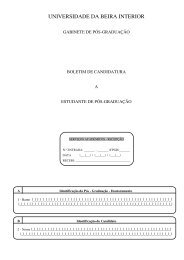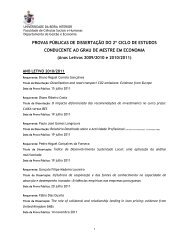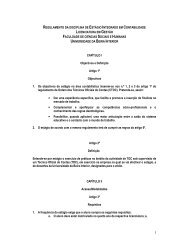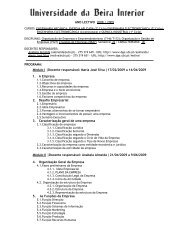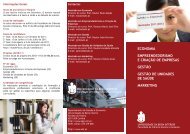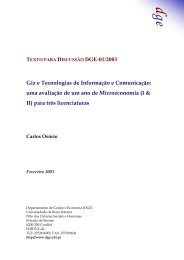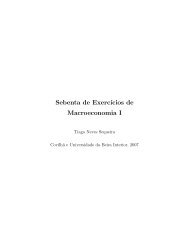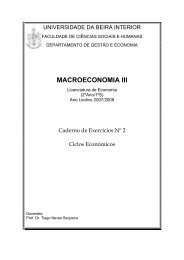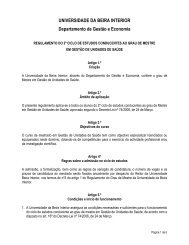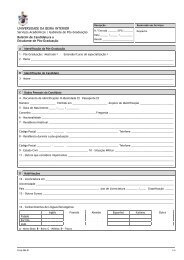Sebenta de Exercícios Resolvidos - O DGE - UBI
Sebenta de Exercícios Resolvidos - O DGE - UBI
Sebenta de Exercícios Resolvidos - O DGE - UBI
You also want an ePaper? Increase the reach of your titles
YUMPU automatically turns print PDFs into web optimized ePapers that Google loves.
10<br />
CAPÍTULO 1. CONSUMO<br />
Solução 7 a) Apresenta-se o padrão <strong>de</strong> rendimento esperado (Y e<br />
i )<br />
e o padrão <strong>de</strong> rendimento realmente verificado (Y i ) na seguinte<br />
tabela:<br />
i 1 2 3 4<br />
Yi e 100 120 130 150<br />
Y i 100 130 91 200<br />
b) Uma vez que a função <strong>de</strong> utilida<strong>de</strong> é aditiva e a taxa <strong>de</strong><br />
juro real é igual à taxa <strong>de</strong> <strong>de</strong>sconto intertemporal, sabemos que o<br />
agente alisa completamente o consumo, pelo que po<strong>de</strong>mos resolver<br />
o problema recorrendo apenas à restrição orçamental intertemporal.<br />
No 1 o periodo ele consome<br />
C(1 +<br />
1<br />
1 + 0.05 + 1<br />
(1 + 0.05) 2 + 1<br />
120<br />
3<br />
) = 100 +<br />
(1 + 0.05) 1 + 0.05 + 130<br />
(1 + 0.05) 2 + 150<br />
(1 + 0.05) 3<br />
⇔ C 1 = 119.6492; S 1 = 100 − 119.6492 = −19.6492<br />
No segundo período ele refaz as suas contas <strong>de</strong>vido ao aumento<br />
<strong>de</strong> salário inesperado:<br />
C(1 +<br />
1<br />
1 + 0.05 + 1<br />
130<br />
2<br />
) = 130 +<br />
(1 + 0.05) 1 + 0.05 + 150<br />
2<br />
− 19.6492(1 + 0.05)<br />
(1 + 0.05)<br />
⇔ C 2 = 129.13; S 2 = 130 − 129.13 = 0.87<br />
No terceiro período ele refaz as suas contas <strong>de</strong>vido ao período<br />
<strong>de</strong> doença, também inesperado<br />
C(1 +<br />
1<br />
150<br />
) = 91 +<br />
1 + 0.05 1 + 0.05 − 19.6492(1 + 0.05)2 + 0.87(1 + 0.05)<br />
⇔ C 3 = 109.1526; S 3 = 91 − 109.1526 = −18.1526<br />
No ultimo periodo, vai consumir C 4 = 109.1526 + 50 = 159.1526 e vai<br />
poupar S 4 = 40.8474. S 1 (1 + r) 3 + S 2 (1 + r) 2 + S 3 (1 + r) + S 4 = 0<br />
c) Po<strong>de</strong>-se concluir que apenas variações inesperadas no rendimento<br />
conduzem a variações no consumo quando a função <strong>de</strong><br />
utilida<strong>de</strong> é aditiva e a taxa <strong>de</strong> juro real igual à taxa <strong>de</strong> <strong>de</strong>sconto<br />
intertemporal.<br />
Assim, a explicação para a existência <strong>de</strong>



